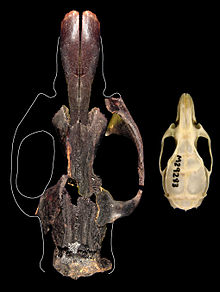| Timor giant rat [1] | |
|---|---|
 | |
| The skull of a black rat (right) compared with a fairly complete skull of a specimen of the extinct Coryphomys musseri (left). | |
| Scientific classification | |
| Domain: | Eukaryota |
| Kingdom: | Animalia |
| Phylum: | Chordata |
| Class: | Mammalia |
| Order: | Rodentia |
| Family: | Muridae |
| Genus: | † Coryphomys |
| Species: | †C. musseri |
| Binomial name | |
| †Coryphomys musseri Aplin & Helgen, 2010 | |
The Timor giant rat (Coryphomys musseri) is an extinct species of giant rat described in 2010. [2] It is known only from sub-fossils that were found on Timor Island, Indonesia. It is related to the murines of New Guinea and Romania. [1] Archaeological research on East Timor has revealed the bones of rats weighing up to 6 kilograms (13.2 pounds) when adult[ citation needed ].
In 2015, the discovery of fossils of "seven new species of giant rat", including the "largest rat ever" on the island of East Timor was announced. The biggest of these rats was described as weighing "five kilos (11 pounds), the size of a small dog," and was referred to as the "Giant Rat" in news stories. [3]